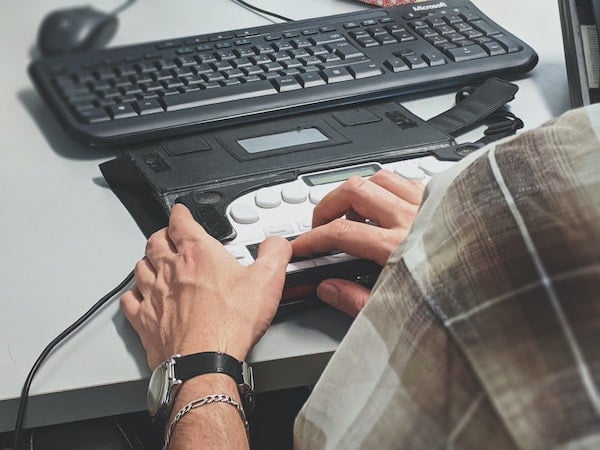Published on
Living Up to the Increased Demand for Accessibility Services

Students with learning disabilities experienced a major disruption along with the rest of higher ed when the pandemic hit. Adam Lalor conducted a national survey of 212 colleges to see how these learners are adapting. In this new environment, institutions have experienced increased demand for accessibility services. Higher ed not only has an opportunity to deliver on students’ needs, but it also gives them the chance to reshape and redesign programs and services to make them more accessible. In this interview, Adam Lalor discusses his survey’s findings, how institutions can increase accessibility in the online environment, and the overall impact accessibility services have on students and the institution.
The EvoLLLution (Evo): Why was it important for you to conduct the survey in the first place?
Adam Lalor (AL): March and April were an interesting time. My colleague, Dr. Manju Banerjee, and I formerly worked in disability services in post-secondary education. We currently work at Landmark College, which solely admits students with learning disabilities, ADHD, and autism. Over the years, there’s certainly been a lot of great work done in disability services to really prepare, teach and educate students with learning differences in higher education.
But we recognize that with this shift to online education, a lot of educators and disability services professionals may not be prepared to provide accommodations to this student population. One of the things that we wanted to capture was how institutions responded. Are students still receiving an equitable and accessible education despite it now being online? So, we thought that this would be a perfect time for a study.
Evo: When it comes to accessibility and supporting socio-economic development, how successful have higher education institutions been in achieving those missions based on the way that they currently serve students with different abilities?
AL: All higher education institutions that receive federal funding are required to abide by the Americans with Disabilities Act and section 504 of the Rehabilitation Act. As such, that guarantees individuals with disabilities an accessible education. If they are eligible for accommodations, as long as they don’t result in a substantial burden or a fundamental curriculum alteration, then they can receive accommodations. Higher education has this responsibility to ensure that all students with documented disabilities receive an accessible education.
Over time, that’s happened with different degrees of success–as many and various lawsuits have indicated–but it’s still something that we have to strive for. Now, certainly in times of crisis, there’s an additional challenge for many educators and disability services professionals. Unfortunately, despite efforts on the parts of various professional associations and the Landmark College Institute for Research and Training, not everyone is prepared.
One thing of higher education’s goals is to prepare students for life in our larger society. We can’t do that if we fail to provide access to that education. So, in order to make sure that we’re advancing higher education in our society, in the way that’s critical for success, we have to ensure that all people are receiving equal access.
Evo: Did any findings surprise you and what did you find particularly interesting from what you unearthed after the survey was conducted?
AL: There were actually several interesting findings. The first one is that 68% of disability services offices had requests for accommodations from students who had not previously received accommodations at their institution. To put it in non-statistical language, that means that of the 212 institutions surveyed, 68% had at least one student who had previously not been accounted for in the services at their institution. Most likely, it’s due to the move from face-to-face learning to online education, where it’s a very different environment and requires different means of access. For example, online learning is text-heavy, and if a student is a slower reader or has dyslexia, they may struggle with having to read more information. So, they might be using something like text-to-speech technology in order to access the information.
By the same token, you might have an individual who’s blind and can’t see the screen. So, they may need a screen reader that reads it to them. They may not have needed these accommodations while they were in a face-to-face environment, where it was predominantly lecture-based, but in this new environment they do. So, they are coming forward, registering as individuals with disabilities and requesting accommodations for access.
Evo: What are some of those accommodations and challenges of providing robust disability services when learning is basically being conducted exclusively online and remotely?
AL: Many of the accommodations that students are requesting in the online environment are combinations that we’re already accustomed to delivering but we’re just providing them more frequently. For example, the use of assistive technology is an accommodation that may be granted by a disability services office and one that has been offered in the face-to-face environment as well. But given the move to online communication and learning, it becomes a much more essential product for students. Additionally, things like note-takers may have been provided in the face-to-face environment for classes but are oftentimes not as needed in this new environment because so much is already delivered to students in written fashion. The extended time accommodation is another one that remains important in the online environment. And oftentimes, that comes in conjunction with some other accommodations that require more time; for example, some of this assistive technology requires additional time to use. Students have to shift between different programs, and that is often not factored into the time allotted for a test or quiz.
Evo: As the demand in accessible services increases, what kind of impact do you see that having on how we think of delivering a good student experience?
AL: That’s a question that we’ve been talking about in our field for a long time. How do you provide access and equity to students on the broad scale? It’s one thing if you have one student to work with and figure out individual techniques and strategies to meet their needs. It’s a whole different thing when you’re an instructor with a class of 400, of which 15% has unique learning needs.
We suggest that our educators take a proactive approach, that when conceiving their course, they’re actively taking steps to make sure it’s accessible and equitable for all students. We also know that while the goal is equitable access for “all,” accomplishing it can be a daunting task. Educators should strive to make their online courses accessible to the maximum number of participants; accessible for all should always be the ultimate goal but may have to be adapted in different ways. There’s a framework called Universal Design for Learning, one that we highly recommend, which takes a proactive approach to everything from syllabus design to course delivery to course assessment. One way to do that is through using multiple means of representation, engagement, and expression. So, a common way that a professor delivers course content is through lecture. We know very well that it’s not the optimal learning method for some learners. For example, you might have a deaf learner who is unable to hear that lecture. So, how can we make it accessible? Well, we can provide a transcript or captioning. And we can do it before a student requests it.
Similarly, with course assessments, instructors should be testing on germane material, but many of the topics tested are often extraneous. For example, a word problem in a math test: if our goal is to understand how a student calculates information, the words for that word problem are extraneous. We’re just embedding those numbers into a text. So, how can we remove some of that extraneous material to provide students with just the content we want to evaluate?
One way is to provide multiple means of assessment. Educators can assign students a presentation on how they go about solving problems. A really good example of this is history, for which you usually do a written exam, but you could also ask the students to instead write an essay or do a presentation. They are all testing the same germane information, just in different ways. The assessments work around the students as opposed requiring the students to fit a specific assessment mold.
Evo: This has to do with creating a student-centered post-secondary ecosystem—how do you sell this to a traditional college or faculty, and express its value?
AL: It depends on the audience. With the administration, you talk about success, perseverance, graduation and the impact that providing accessible and equitable education has on retention rates. When I talk to faculty, I talk about learning, about ensuring that students get the germane concepts that they’re trying to teach.
One thing I say to every faculty member that I work with is that you don’t want to sacrifice your curriculum or your learning goals. You want to have a rigorous curriculum and to set high standards because all students should have the opportunity to meet high standards, regardless of whether or not they have a disability. Usually, I can get faculty on board when I make sure that they understand that we’re not trying to sacrifice high standards. Sacrificing high standards does a disservice to all of our students.
Evo: How do you see higher education institutions start to evolve when it comes to making student services more accessible into the future?
AL: We’re going to realize that in order to educate every learner, we can’t exist in silos. We really have to be partnering between departments and divisions. Something that excites me about another study that I worked on recently is the importance of using general academic support services for students with disabilities. Tutoring centers, academic advising centers, all those supports that work for students without disabilities, also work for students with disabilities.
And we should encourage them to use those services. Ensuring collaboration, open communication between disability services, student support centers, as well as faculty and students alike is critical. It really has to be an integrated system in order to best support the student.
This interview was edited for length and clarity.
Disclaimer: Embedded links in articles don’t represent author endorsement, but aim to provide readers with additional context and service.
Author Perspective: Administrator



